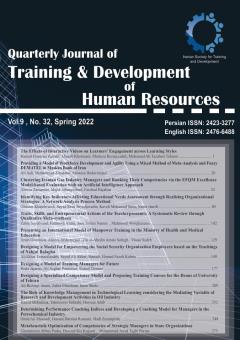طراحی مدل توانمندسازی منابع انسانی درسازمان ملی استاندارد ایران
الموضوعات :
1 - دانشگاه عدالت محور
الکلمات المفتاحية: مدیریت منابع انسانی, توانمندسازی منابع انسانی, سازمان ملی استاندارد ایران, بهره وری,
ملخص المقالة :
امروزه در سازمانهای پیشرو، توانمندسازی منابع انسانی به عنوان یک فرایند ضروری و پراهمیت، دنبال میشود. با توجه به تفاوت و تنوع تعاریف و تعابیر موجود در حوزه توانمندسازی منابع انسانی، برخورداری از مدلی معتبر و اجرایی، از جمله نیازهای اساسی سازمانهای هزاره سوم به شمار میرود که بر این اساس، هدف از تحقیق حاضر طراحی مدل توانمندسازی منابع انسانی در سازمان ملی استاندارد ایران، بوده است. بر این اساس، رویکرد مورد استفاده در تحقیق حاضر، رویکرد آمیخته است که جهت طراحی و تدوین مدل جامع از رویکرد کمی و کیفی (آمیخته) استفاده گردید. همچنین تحقیق حاضر از نظر روششناسی در دسته مطالعات اکتشافی، پيمایشي، علّي، كاربردي و بنیادی جای دارد. جامعه آماری تحقیق نیز شامل کارکنان سازمان ملی استاندارد ایران (400 نفر) و همچنین خبرگان و اساتید دانشگاهی حوزه توانمندسازی منابع انسانی و مدیران منابع انسانی سازمان ملی استاندارد بود که از این بین در ابتدا به روش مصاحبه در بین خبرگان و اساتید دانشگاهی حوزه توانمندسازی منابع انسانی و مدیران منابع انسانی سازمان ملی استاندارد، مقولههای مورد نظر به منظور طراحی مدل استخراج شده و بعد از آن پرسشنامه تحقیق تهیه و در بین کارکنان سازمان توزیع و با نرخ بازگشت75.5 درصد، تعداد 302 پرسشنامه بازگشت و مورد تحلیل قرار گرفته و نتایج نشان از معناداری روابط و اجزای مدل ارائه شده دارد.
[1] A.K. Mishra, Organizational responses to crisis: The role of mutual trust and top management teams, (1992).
[2] Esfandiari, Mohammad Javad, Adabi, Hamidreza. Investigating the relationship between knowledge management and psychological empowerment of human resources in Tehran Municipality. Urban Management Studies, 2016; 8 (25): 12-24.
[3]Abdulli, Abdul Rahim, grandson of Ibrahim, Bijan. Employee Empowerment: The Golden Key to Human Resource Management. Publication of editing.
[4] S. Menon, Employee empowerment: An integrative psychological approach, Appl. Psychol. 50 (2001) 153–180.
[5] L.R. Men, How employee empowerment influences organization–employee relationship in China, Public Relat. Rev. 37 (2011) 435–437.
[6] K. Armitage, Empowering People at Work, Manager. (1998) 28.
[7] Nasrabadi, Mohsen Niazi, Mohammad Karkanan. 1388. "Empowerment based on social capital strategy." Tadbir (1388) 21–26.
[8] K. Grove, J. Pugh, Assemblage thinking and participatory development: Potentiality, ethics, biopolitics, Geogr. Compass. 9 (2015) 1–13.
[9] S.L. Bodner, Dimensional assessment of empowerment in organizations, University of North Texas, 2003.
[10] Moghaddam, Bakhtiari Hassan, Ismail Ahmadi. 2010. "The role of management strategies in empowering managers." Disciplinary Management Studies.
[11] D.M. Chavis, A. Wandersman, Sense of community in the urban environment: A catalyst for participation and community development, in: A Quart. Century Community Psychol., Springer, 2002: pp. 265–292.
[12] A. Wandersman, P. Imm, M. Chinman, S. Kaftarian, Getting to outcomes: A results-based approach to accountability, Eval. Program Plann. 23 (2000) 389–395.
[13] Z. Che, H.S. Wang, C.-L. Chuang, A fuzzy AHP and DEA approach for making bank loan decisions for small and medium enterprises in Taiwan, Expert Syst. Appl. 37 (2010) 7189–7199.
[14] H.K. Spence Laschinger, J. Anne Sabiston, L. Kutszcher, Empowerment and staff nurse decision involvement in nursing work environments: testing Kanter’s theory of structural power in organizations, Res. Nurs. Health. 20 (1997) 341–352.
[15] D. Moura, A. Orgambídez-Ramos, S.N. de Jesus, Psychological empowerment and work engagement as predictors of work satisfaction: A sample of hotel employees, J. Spat. Organ. Dyn. 3 (2015) 125–134.
[16] G.M. Spreitzer, An empirical test of a comprehensive model of intrapersonal empowerment in the workplace, Am. J. Community Psychol. 23 (1995) 601–629.
[17] K.W. Thomas, B.A. Velthouse, Cognitive elements of empowerment: An “interpretive” model of intrinsic task motivation, Acad. Manag. Rev. 15 (1990) 666–681.
[18] A. OrgambÃdez-Ramos, G. Gonçalves, J. Santos, Y. Borrego-Alés, M.I. Mendoza-Sierra, Empowering Employees: A Portuguese Adaptation of the Conditions of Work Effectiveness (CWEQ-II), Psicologia. 29 (2015) 1–10.
[19] M. Lautizi, H.K.S. Laschinger, S. Ravazzolo, Workplace empowerment, job satisfaction and job stress among Italian mental health nurses: an exploratory study, J. Nurs. Manag. 17 (2009) 446–452.
[20] Abbas Saleh Ardestani, Mohammad Hassan Azma ,. (1394). Designing a model of psychological empowerment using the structural equation model in the headquarters of the Martyr and Veterans Affairs Foundation. The first international conference on industrial engineering, management and accounting, electronically, Alborz Research Institute.
[21] Farhad, Abbas Karkaabadi, Alireza Amirkabiri, Lashgar Ara ,. 2011. "Designing a model for human resource empowerment in the Ministry of Interior." Islamic Azad University, Islamic Azad University, Central Tehran Branch, Faculty of Management.
[22] Kurdish, Saeed Abbasi, Baqir. 1388. "Identifying and explaining the model of employee empowerment in Iranian government organizations (Case study of Yazd province)." Management Research 2 (3): 75–94.
[23] L.-C. Wu, C.-S. Ong, Y.-W. Hsu, Knowledge-based organization evaluation, Decis. Support Syst. 45 (2008) 541–549.
[24] D.H. Kim, A framework and methodology for linking individual and organizational learning: Applications in TQM and product development, (1993).
[25] S.E. Seibert, G. Wang, S.H. Courtright, Antecedents and consequences of psychological and team empowerment in organizations: a meta-analytic review., J. Appl. Psychol. 96 (2011) 981.
[26] M. Pigeon, F. Montani, J.-S. Boudrias, How do empowering conditions lead to empowered behaviours? Test of a mediation model, J. Manag. Psychol. (2017).
[27] M. Khaled, M. Ramadan, H. El-Hage, A. Elmarakbi, F. Harambat, H. Peerhossaini, Review of underhood aerothermal management: Towards vehicle simplified models, Appl. Therm. Eng. 73 (2014) 842–858.
[28] T.L. Robbins, M.D. Crino, L.D. Fredendall, An integrative model of the empowerment process, Hum. Resour. Manag. Rev. 12 (2002) 419–443.
[29] A. Newman, C. Dennis, L.-T. Wright, T. King, Shoppers’ experiences of digital signage-a cross-national qualitative study, Int. J. Digit. Content Technol. Its Appl. 4 (2010) 50–57.
[30] L.-Y. Sun, Z. Zhang, J. Qi, Z.X. Chen, Empowerment and creativity: A cross-level investigation, Leadersh. Q. 23 (2012) 55–65.
[31] L. Song, H. Chen, H. Gu, H. Huang, H. Du, Set covering in fuel-considered vehicle routing problems, Theor. Comput. Sci. 607 (2015) 471–479.


